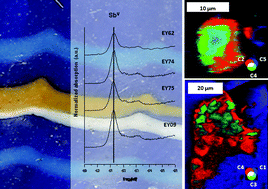Synthesizing lead antimonate in ancient and modern opaque glass†
Abstract
Through the study of

- This article is part of the themed collection: Synchrotron Radiation in Art and Archaeology
* Corresponding authors
a
C2RMF (UMR171) Centre de Recherche et de Restauration des Musées de France, Palais du Louvre, Porte des Lions 14 Quai François Mitterrand, Paris, France
E-mail:
sophia.lahlil@culture.gouv.fr
Fax: +33147033246
Tel: +33140202491
b ESRF European Synchrotron Radiation Facility, 6 rue Jules Horowitz, BP 220, Grenoble Cedex 9, France
c Institute of Physics, Jan Kochanowski University, Kielce, Poland
d Paul Scherrer Institut, Villigen PSI, Switzerland
e IMPMC Institut de Minéralogie et de Physique des Milieux Condensés, Université Pierre et Marie Curie, Université Paris Diderot IPGP, 4 Place Jussieu, Paris Cedex 05, France
Through the study of

 Please wait while we load your content...
Something went wrong. Try again?
Please wait while we load your content...
Something went wrong. Try again?
S. Lahlil, M. Cotte, I. Biron, J. Szlachetko, N. Menguy and J. Susini, J. Anal. At. Spectrom., 2011, 26, 1040 DOI: 10.1039/C0JA00251H
To request permission to reproduce material from this article, please go to the Copyright Clearance Center request page.
If you are an author contributing to an RSC publication, you do not need to request permission provided correct acknowledgement is given.
If you are the author of this article, you do not need to request permission to reproduce figures and diagrams provided correct acknowledgement is given. If you want to reproduce the whole article in a third-party publication (excluding your thesis/dissertation for which permission is not required) please go to the Copyright Clearance Center request page.
Read more about how to correctly acknowledge RSC content.
 Fetching data from CrossRef.
Fetching data from CrossRef.
This may take some time to load.
Loading related content
